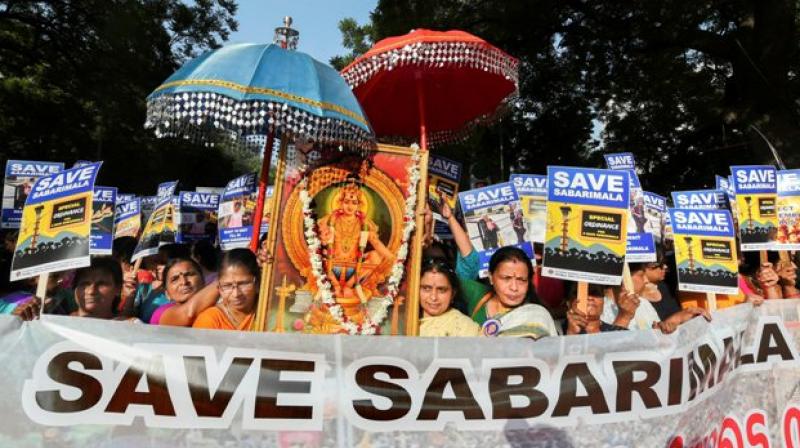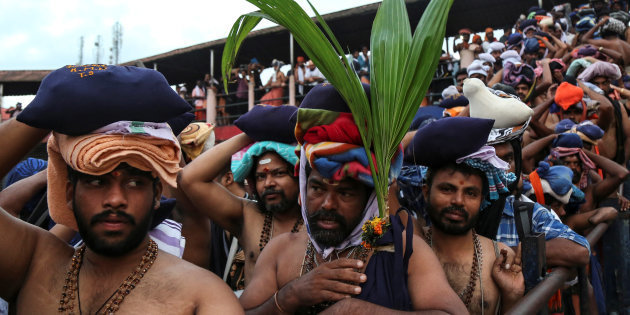
By P.K.Balachandran/DailyFT
Kerala has been in unprecedented political and social turmoil since September 28, 2018. It was on that day that the Indian Supreme Court had allowed women of all age groups to worship at the 800-year old shrine for Lord Ayyappa at Sabarimala.
Conservatives Hindus were up in arms against the judgment, as leftists and liberals braced themselves to face a conservative onslaught.
The highest court in the land had struck down Rule 3(b) of the Kerala Hindu Places of Public Worship (Authorization of Entry) Rules, 1965 which barred women of “reproductive age” (10 to 50) from worshiping at the shrine devoted to a deity who is believed to be celibate.
Initially, the court’s verdict only triggered a verbal debate between conservatives and traditionalists, on the one hand, and progressives on the other. But given the support the verdict was getting from the ruling Left Democratic Front (LDF) – with the State government offering to give police protection to women who want to worship at the hill shrine – the issue got politicized, though the government’s intention was merely to implement a court order.
The Bharatiya Janata Party (BJP), which is in power in the Central government in New Delhi, quickly sensed the political value of the issue in Kerala, where it is yet to make its presence felt.
In the 2014 parliamentary elections, the BJP did not get a single seat from the 20 up for grabs. And in the 2016 State Assembly elections, it got just one of the 140 seats. This is quite strange since Kerala has large and politically organized Muslim and Christian populations. In theory, Kerala should be a happy hunting ground for a Hindutva party like the BJP, but in practice, it has not been.
No wonder then that the BJP, which is now trying hard to enter South India, should want to reawaken and build a Hindutva constituency for itself. And the fact that the next Indian parliamentary elections are due in April-May 2019, gives this project some urgency.
The BJP re-awakened the dormant pro-Hindutva and conservative Hindu and caste outfits in Kerala. And, with the help of the head of the Ayyappa temple, a local Prince who is committed to maintaining tradition as he sees it, kicked off a movement opposing the verdict.
The once militant Nair Service Society (NSS), which had forced Prime Minister Jawaharlal Nehru to dismiss Kerala’s first Communist government in July 1959, was reactivated. The NSS filed an appeal against the Supreme Court judgment. The appeal is to be heard on January 22 this year.
With the BJP taking up the issue against the LDF government, the Congress party, which sees the LDF as its principal rival in the State and the BJP as its rival at the all-India level, also jumped into the fray to claim a share of the political cake.
To awaken the left, and the non-communal and liberal constituency, the LDF organized a 631 km long women’s human wall (the Vanitha Madhil) a human chain across Kerala. To counter this, the Hindutva outfits under the umbrella organization Sabarimala Action Council (SAC) shut down the State on Thursday with a call for a dawn to dusk hartal.
A BJP activist was sacrificed in the struggle while the temple authorities carried out a “purifying rite” after two women sympathizers of the LDF, Bindu and Kanakadurga, offered worship at the temple with police protection.
The State Congress party also joined the protests and announced that it is observing Thursday as a “Black Day”, leaving the CPI(M) led government to hold the fort against a mounting conservative offensive.

Controversy Over Tradition
While it is obvious that the temple entry issue is being used by the political parties to garner support ahead of the April-May 2019 parliamentary elections, there has been a long-standing dispute over the “tradition” of not allowing women of the reproductive age (10 to 50) to worship at the temple.
The traditionalists say that Lord Ayyappa is a celibate and that his celibacy has to be protected from women of the reproductive age group. But others say that Lord Ayyappa is gender neutral because he was born of the union of Lord Shiva and Lord Vishnu (with Vishnu coming in the form of Mohini, a celestial seductress). Therefore, it is argued that gender and the reproductive age group should not be an issue with him at all.
The progressives also point out that the current dispute is between the need to maintain the sanctity of a claimed or a controversial tradition and the need to enforce a constitutional right to gender equality. The latter should get precedence in this day and age, they argue.
Hinduization of Buddhist Deity?
According to historian A. Sreedhara Menon, there was no bar on entry of women till 1950. It was in 1950 that the “Hinduization” of the Ayyappa temple and the Ayyappa cult began, he avers. And with “Hinduization” came the ban on women of the reproductive age group. Menon proffers the theory that the Ayyappa cult was originally Buddhist but it acquired Brahmanical overtones over time.
Unlike Brahminical Hinduism, the Ayyappa cult is non-casteist and equalitarian, he points out. It stresses not elaborate and expensive rituals but simple abstemiousness.
“Ayyappa devotees strictly follow non-violence, vegetarianism and abstention from sex during the two months before the pilgrimage. It resembles the Ahimsa principles practiced by Buddhists”, Menon is quoted as saying.
In her chapter in Introduction to Kerala Studies M.Srikala Nair says that Lord Ayyappa is but a representation of the Nilakantha Avalokiteswara depicted in the Buddhist texts.
Unlike Brahminical Hinduism, which is exclusivist, the Ayyappa cult is non-discriminatory and syncretic, representing a long-standing folk-level integration of religions in India. This is seen when Ayyappa devotees visit a shrine for a Muslim devotee of his called Vavar (or Babar) on their way to the hill-top Ayyappa shrine. And when they come down after worship at the Ayyappa temple, the devotees visit a church to return theirmalas(string of beads) which they had worn as part of the period of abstemiousness ahead of the pilgrimage.
It is said that the “Hinduization” of the ancient and indigenous Ayyappa cult began in 1950 when a major fire damaged the temple. The Hindu Mahamandalam, which cropped up at that time, called for ahartal(general strike) and conducted a ceremony to re-install the idol and purify the temple on June 25, 1950.
Under the leadership of Akhila Bhartha Ayyappa Seva Sangam, an ‘Ayyappa Jyothi’ (Ayyappa’s Torch) was ceremonially taken around Kerala and Tamil Nadu. Later, restriction on the entry of women was enforced, albeit, fitfully and imperfectly under Rule 3(b) of the Kerala Hindu Places of Public Worship (Authorization of Entry) Rules, 1965.
But a definitive ban came only after a 1991 Kerala High Court ruling it is said.
Both the conservatives and progressives had presented their cases on various occasions in the past, and continue to do so. The progressives point out that the ban on women was never strictly imposed. It is recalled that in 1939, the Maharani of Tranvancore had conducted a ritual for her child in front of the sanctum sanctorum. The Director of the Travancore Devaswom Board (which regulates the affairs of Hindu temples) had submitted in writing in 1991 that ban on women was not part of the temple’s customs. It is also pointed out by Malayalam writer N.S.Madhavan that as recently as 1986, a dance sequence in the Tamil film Nambinaal Keduvadhillai, starring Jayashree, was shot on the 18-steps leading to the temple.
According to some accounts, in the past, women were barred only on three occasions in a year. Others say that they could go up to a point but not the sanctum sanctorum and that they are only forbidden to take the holy 18 steps towards the sanctum sanctorum.
(The featured image at the top shows conservative women demonstrating in favor of not allowing women of child-bearing age)
